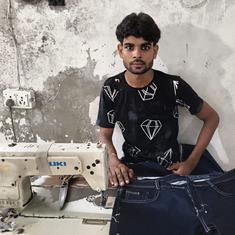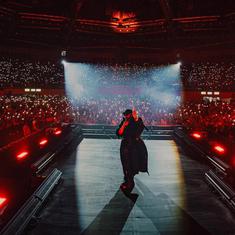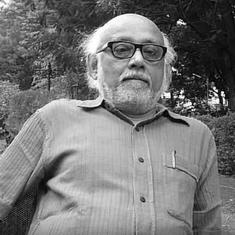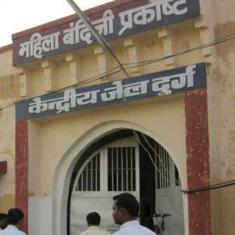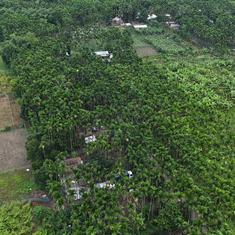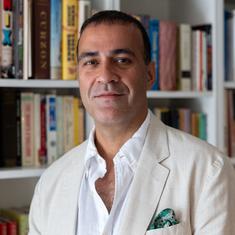In Defence Colony – a lush, tony locality primarily built for retired defence personnel in the heart of prosperous South Delhi – a Muslim security guard was blamed when his employers, three of a family, tested positive for the novel coronavirus in the first week of April.
Two days later, on April 8, the family filed a police complaint against the guard because he had allegedly attended a religious gathering of the orthodox sect called the Tablighi Jamaat in Nizamuddin– since declared a “hotspot” – about 3.5 km away.
The same day, the local police station sent a Whatsapp message to residents expressing “doubt” about the guard, identified only as Mustaqim, who had gone into hiding. “So all are requested to stay a bit more alert and keep watch on your [domestic helps], Drivers and Guards,” said the message sent from the station house officer’s phone.
A week before the Whatsapp message, on April 1, the government first claimed – with little evidence, since India is not, experts said, testing enough of its population – that the Tablighi meet was a major national Covid-19 source.
Selective testing
The number of Tablighis who tested positive was high because around 9,000 who attended were tracked and quarantined. This did not happen with a series of other mass gatherings in the days after the lockdown. These include festivals at least eight temples nationwide between March 9 to March 19 where thousands gathered. The latest such lockdown-defying festival was held on April 16 in Karnataka’s Kalburgi district, which on March 10 reported India’s first Covid-19 death and is now an outbreak hotspot.
In Madhya Pradesh, where on March 23 India’s ruling Bharatiya Janata Party engineered a split in the ruling Congress and returned to power, a celebratory meeting sparked a rash of infections: health officers, bureaucrats and politicians who attended were quarantined.
Selective bias against India’s Muslims first emerged in after the Centre said the Tablighi meet held between March 13 and 15 at the Nizamuddin Markaz – the global headquarters of the sect, a missionary movement that encourages Muslims to return to the faith as originally conceived – was “not a national trend”.
On March 31, India saw its biggest single-day spike in cases of Covid-19 until then, with a 17% rise in 12 hours, or 227 cases in 24 hours. Tamil Nadu and New Delhi recorded the highest jump with 17 and 24 new cases in a single day bringing the total to 1,251, according to the Ministry of Health and Family Welfare.
That number has since been eclipsed, with as many as 14,759 active cases across the country on the morning of April 21, with the spike caused by the Tablighi tests apparently absorbed.

On April 8, seven days after the government first made the link to the Tablighis explicit, Mike Ryan, the Emergency Program Director of the World health Organisation, expressed the organisation’s disapproval. “This does not help,” said Ryan. “Having Covid-19 is not anybody’s fault. Every case is a victim. It is important that we do not profile the cases on the basis of racial, religious and ethnic lines.”
But the profiling was done, and once it was, a tsunami of fake news followed. After the government’s religious profiling, pro-government television channels and social media began accusing those who attended the gathering and Indian Muslims in general of not just being responsible for the outbreak but deliberately spreading it.
Seeds of hate
Over 22 days since March 30, an Article14 forensic examination revealed how the government’s religious profiling sparked abuse against Muslims, boycotts of their businesses and boycotts of individuals, including Muslim health workers and patients, and a rash of hate crimes.
Media Scanner, a fact-checking platform, compiled a list of at least 69 fake videos against Muslims and listed at least 28 attacks prompted by online abuse. Joyojeet Pal, Associate Professor at the University of Michigan, and three others found “a rise in the number of debunked misinformation, especially following the third week of March.”
Pal’s study confirmed the progression of events that followed the government’s religious profiling. “A key 30-day period”, from March 14-April 12, “was dominated by discussions of a possible lockdown and about infections”; the discourse gradually “changed to Muslims and religion more significantly”, said the study.
“This incident [the spike in Covid 19 cases attributed to the Tablighi Jamaat] triggered a news cycle that is dictating talk points even now,” said Pratik Sinha, co-founder of fact checking website AltNews. “In a pandemic, it is important to know the root cause of a spike. The Tablighi incident was a hotspot, but the analysis of this incident, demonising a particular community, is worrying.”
The fake-news cycle was clear: print and television media and social media were feeding off each other. Social-media users picked manipulated, exaggerated or fake news, spun it further, sometimes; in turn, the media picked up such posts and spun them as news.
On April 19, Prime Minister Narendra Modi spoke up for the first time. He tweeted: “#COVID19 does not see race, religion, colour, caste, creed, language or borders before striking. Our response and conduct thereafter should attach primacy to unity and brotherhood. We are in this together.”
COVID-19 does not see race, religion, colour, caste, creed, language or borders before striking.
— PMO India (@PMOIndia) April 19, 2020
Our response and conduct thereafter should attach primacy to unity and brotherhood.
We are in this together: PM @narendramodi
The tweet came within an hour of a body that advises the 57-member Organisation of Islamic Cooperation, many of them India’s strategic partners, criticised the “unrelenting vicious #Islamophobic campaign in #India maligning Muslims for spread of #Covid-19 as well as their negative profiling in media subjecting them to discrimination & violence with impunity”.
Here is how the tide of Islamophobia unfolded over 22 days, given life by Modi’s government pointing the finger at the Tablighis and amplified into a wider attack by his party colleagues and supporters.
The timeline
March 29: Shift in media focus
The home ministry had, as early as March 21, written to all states and Union Territories to “identify, screen and quarantine” 824 foreign members of the Tablighi Jamaat who had travelled across India. These members had entered India without being screened at airports, which Modi had falsely claimed on April 14, were screening and identifying everyone entering the country.
Until March 29, the media was focussed on reporting how thousands, perhaps millions, of migrant workers – jobless, homeless and unprepared because the government imposed a 21-day lockdown with four-hour notice – were streaming out of cities, attempting to make long journeys home by scooter, cycle or on foot.
By evening that day, news about the spike broke. The explicit connection by the government was made three days later.
March 30: First fake news crop up
The Nizamuddin cluster was not immediately blamed for the “sudden” spike in infections. The Centre cautioned against fault finding and said failure to inform the authorities in time and lack of public support were the reasons behind the spike.
But politicians, media outlets and content on social media had already widened concern over the Tablighi meeting to include all Indian Muslims. Unrelated videos supposedly showing Muslims licking utensils – since debunked – to deliberately spread the coronavirus started making the rounds.
The same evening, two Bharatiya Janata Party leaders linked the rise to the Nizamuddin Markaz.
At 9.20 pm, Gautam Gambhir, BJP MP from East Delhi, asked what “people gathering at Nizamuddin (were) thinking?” An hour later, BL Santosh, the party’s national General Secretary, said the “Markaz in Nizamuddin” is a new “new hot spot of #coronavirus”.
An unauthenticated audio clip quoted cleric Mohammed Saad, the head of the Delhi Markaz, saying “there is no need of social distancing also it is not written anywhere in our religion” began featuring across news channels.
Wire agency Indo Asian News Service reported what Saad was supposed to have said but added it “is not authenticating the audio…” India TV reported the Saad audio, but glossed its authenticity.

March 31: #CoronaJihad and other hateful rhetoric
A day after the single largest spike was registered, a cacophony of voices blaming the Jamaat built through the day. Just after midnight, at 12.34 am senior journalist Abhijit Majumdar tweeted, recommending that “Indian agencies should seriously probe if #CoronaJihad was a ground reality.”
The #CoronaJihad hashtag became one of the most trending phrases on and off social media. “Since March 28, tweets with the hashtag #CoronaJihad have appeared nearly 300,000 times [in India] and potentially seen by 165 million people on Twitter,” according to data shared with TIME magazine by Equality Labs, a human-rights advocacy.
Day-long news coverage by many media, especially pro-government ones, shamed Muslims for congregating at the Markaz – here, here, here, here, and here. Terms like “corona bomb”, “betrayal”, “superspreader maulana” and “terrorist” were liberally used, with anchors accusing the Jamaat of intentionally spreading the virus.
As administrators of the Markaz blamed the government’s poor planning, Sambit Patra, national spokesperson for BJP, called it the Tablighi meet “criminal negligence” and the Aam Aadmi Party’s Aatishi Marlena called for “strong action be taken against the administrators”.
Delhi Chief Minister Arvind Kejriwal called the meet a “highly irresponsible act” and asked the police to file a First information report against Maulana Saad. Using the Epidemic Diseases Act, 1897, the police accused Saad of “deliberately, willfully, negligently and malignantly” disobeyed orders for social distancing.
April 1: Claims of ‘Islamic insurrection’
Two days after the biggest spike was recorded, the Centre made the link explicit and said the Tablighi Jamaat caused the rise in the number of Coronavirus cases in India.
Early that morning, Amit Malviya, head of the BJP’s information technology cell, tweeted that the Tablighi gathering was “illegal” and alleged an “Islamic insurrection”, as he linked the pandemic to ongoing communal tension after the contentious Citizenship Amendment Act was passed in December 2019 during Parliament’s winter session.
The campaign against Muslims was in full stride. Islamophobic hashtags, such as #CoronaJihad, #Covid-786, #NizamuddinIdiots, trended on social media platforms. Facebook user Ankita Saxena’s post of a video of a Sufi ritual portrayed as deliberate mass sneezing meant to spread infections went viral. The post was viewed more than 24,000 times and shared by thousands.
Factcheckers – here and here – said the video was fake news. Twitter took down posts of at least two users and an account was suspended.
That evening, at 8.08 pm, BJP leader Kapil Mishra, whose incendiary statements is believed to have triggered one of Delhi’s worst anti-Muslim communal riots in February, tweeted that members from the Jamaat should be treated like “terrorists”. Union Minority Affairs Minister Mukhtar Abbas Naqvi said, “It is a Talibani crime by Tablighi Jamaat…”
Meanwhile, the Uttar Pradesh police charged Siddharth Vardarajan, the editor of news website The Wire, with “statements creating or promoting enmity, hatred or ill-will between classes”, and “disobeying a public servant” after a report that said the Uttar Pradesh government was insisting on going ahead with Ram Navami celebrations between March 25 and April 2.

April 2: Old videos manipulated
Fake videos on social media are hydra-headed, said experts. Old videos depicting Muslims in poor light surfaced, even as fact checkers worked to dismiss them. A February 2020 video of an undertrial spitting on police officials – first seen on Mumbai Mirror – went viral after a false claim that he had attended the Jamaat.
Voyager Infosec, a digital investigations lab based in Delhi, studied more than 30,000 videos on Chinese video app TikTok and observed that hundreds of these videos were created to target Indian Muslims in a bid to influence them to disregard health advisories and break lockdown orders. The report, submitted to the home ministry, said this was done by instigating them on religious lines by spreading fake information about the Coronavirus.
April 3: Spate of viral videos
The video of a Muslim man licking his thumb while arranging fruit on his cart, presumably to spread the virus, went viral on April 3. It was debunked by fact checkers – here and here. The video got more than 82,000 views at a handle with 91,200 followers called @desimojito, since suspended.
But others like Rosy, with 46,800 followers, and cartoonist Manoj Kureel, with 15,700 followers, regularly post content violating Twitter’s social-media guidelines. Islamophobic caricatures and cartoons are a daily feature on Kureel’s twitter handle, now suspended. One of his posts showed a Muslim man called “Corona Jihad” attempting to push a Hindu off a cliff. It was taken down after 2,000 shares.
Another user Naveen Beelwal, a resident of Ajmer in Rajasthan, shared an old 45-second Malaysian video – originally posted on May 1, 2019, from a Facebook page called “India against Urban Naxals”, to imply that a Muslim employee in a restaurant was spitting in the food before serving it to customers. It got 426,812 views before Facebook warned that the video was fake but did not take it down.
A series of TikTok videos shared by Rahul Gadariya – a computer operator with telecom company Airtel, according to his Facebook page – showed Muslims coughing without covering their mouths and laughing at the suggestion of wearing facemasks. The series has more than 1.1 million views.
April 4: Suggestion that Tablighis be ‘shot’
Maharashtra Navnirman Sena chief Raj Thackeray on April 4 said “unruly Tablighis” would be shot. “The meeting [of Tablighis had taken place] at Markaz in Delhi. Such people be killed by firing bullets at them. Why give them treatment? A separate section be created and their treatment be stopped,” Thackerey was reported to have said.
Thackeray’s statement came after news that Tablighi patients in Ghaziabad, a Uttar Pradesh suburb close to the Delhi border, illtreated and sexually harassed female staff at a hospital. The state government charged six of them with violations of the National Security Act, usually used against terrorists.
Three days later, MP Renukacharya, a Karnataka BJP MLA and political secretary of the state’s chief minister, echoed Thackeray’s idea and said “it was not wrong if such people are shot dead”.
Hindi daily Amar Ujala reported that members of the Tablighi Jamaat quarantined in a facility in the western Uttar Pradesh town of Saharanpur demanded non-vegetarian food and were defecating in the open inside the hospital. The Saharanpur police tweeted that no such thing had happened and the story was taken down. Amar Ujala’s claim was also debunked by fact-checking websites – here and here.
The flood of Islamophobic videos were bolstered by a spate of fake news in prominent regional dailies – here and here. State police forces refuted some claims and, in Gujarat, arrested those responsible for spreading them.

April 5: Attacks on Muslims begin
Four days after it first pointed to the Tablighi meet, the Centre continued to blame them for the spread of the coronavirus, even as abuse and attacks against Muslims grew.
“The doubling rate [of Covid-19 infection] in India is 4.1 days,” health ministry spokesperson Lav Agarwal said during his daily media briefing. “Had the congregation at Nizamuddin not happened and additional cases not come, this would have been about 7.14 days.”
The online abuse against Muslims started to have effects in real life. Wedding-singer-turned-meat-seller Mohammed Dilshad died by suicide after returning from quarantine because he was harassed by neighbours in his Himachal Pradesh village. He took his own life, a day after he tested negative for the coronavirus.
In Punjab, about 80 Muslim men, women and children were chased out of their village, and Muslim milkmen from the same area were denied entry to neighbouring Himachal Pradesh.
April 6: Muslim organisation moves Supreme Court
The Jamiat Ulema-e-Hind, India’s leading council of Muslim theologians, filed a petition in the Supreme Court accusing some in the media of attributing to the Tablighi event “a communal flavour”, using phrases like “Corona Jihad”, “Corona Terrorism”, “Islamic Resurrection” and “Corona Bombs.”
One interpretation of government data suggested the curve was flattening, which meant India may have absorbed the Tablighi spike.
The coronavirus growth rate, which had spiked on March 29, improved by April 6, according to Shamika Ravi, senior fellow at Brookings Institute and a former member of the Prime Minister’s Economic Advisory Council. Her charts, posted on Twitter daily, revealed the growth rate was declining. “The growth of active cases in last 5 days is 6.6% – so doubling every 11 days,” she tweeted.
That did not slow India’s tide of Islamophobia, unofficial or official.
April 7: 150 people booked in Mumbai
A week after the Kejriwal’s Delhi government ordered police action against those who participated in the Jamaat, the Mumbai police followed.
A first information report against 150 people was filed under sections 269 (whoever willfully or negligently does any act which is likely to spread the infection of any disease dangerous to life), 271 (disobedience to quarantine rule), and other relevant provisions of the Indian Penal Code.
A twitter user posted a video of goons forcing Muslim fruit vendors to shut shop in Haldwani in Uttarakhand, even as Hindu vendors were told they could stay open. In an update, posted the next day, Rashid tweeted that police officials had filed a first information report. In Karnataka, two Muslim men were beaten and made to kneel and apologise, for allegedly “spreading” the virus.
On the same day, Equality Labs wrote an open letter to Prime Minister Narendra Modi, Facebook Chief Executive Officer Mark Zukerberg, Twitter Chief Executive Officer Jack Dorsey, and World Health Organisation Director General Tedros Adhanom Ghebreyesus, requesting they try to “stop the rapid spread of Covid-19 Islamophobic hate speech and disinformation”.

April 8: Centre backtracks as criticism grows
As the backlash against Muslims grew, state police nationwide called out some of the fake news. On April 8, the deputy commissioner of police in Noida, Uttar Pradesh, admonished the state bureau of wire agency ANI for “misquoting and spreading fake news” wrongly implying that those who were quarantined in Noida came in contact with Tablighi Jamaat. The quote has now been taken down.
International news outlets, human-rights advocacies and Indian news outlets flagged the rise of Islamophobia in India and hate crimes against Muslims – here, here, here, here, and here.
A week after it blamed the Nizamuddin cluster for the rising number of cases – triggering the torrent of Islamophobic abuse online and offline – the Centre backtracked. The health ministry issued an advisory because “certain communities and areas” were being “labelled purely based on false reports” floating in social media and elsewhere and suggested “an urgent need to counter such prejudices…”
After weeks of classifying cases linked with the Tablighi event as “Markaz Masjid” cases, the Delhi government also called out “anti-social elements” that were “spreading communal hatred during the pandemic.” After this statement the state government reclassified “Markaz Masjid” cases as “Special Operations”.
Three days after Madhya Pradesh Chief Minister Shivraj Chauhan blamed the Tablighis for the rise of cases in the state, experts refuted his claim. Meanwhile, an outbreak in Bhopal after Chauhan was sworn in was debilitating enough to ensure he remained a one-man government, with many colleagues and officials in quarantine.
April 10: Sampling biases and ‘madrasa hotspots’
By selectively focussing on the Tablighi gathering, the impression grew that they alone were responsible for the rise in those testing positive for the coronavirus in India. A Scroll.in explains how “sampling bias drove sensationalist reporting around Tablighi coronavirus cases”.
Disregarding the Centre’s advisory of the previous day, on April 10, India Today’s Rahul Kanwal investigated “madrasa hotspots”, where madrasas were allegedly “hiding the headcount of children at a time when social distancing has been deemed as the only way to tackle Covid-19 outbreak in India.”
The children in the madrasas, mostly from poor families from other villages or town, had no way of getting home after the lockdown was imposed with a four-hour notice. Others were luckier. Eight days later, the Uttar Pradesh government sent 250 buses to Kota, Rajasthan – around 600 km from Lucknow – to evacuate more than 7,500 students stranded there.
April 11: Irrational hate and hospital segregation
On April 11, nine Kashmiri Muslim labourers were attacked by four men wielding cricket bats in the Mandi district of Himachal Pradesh. Some bones were broken.
The village head, or sarpanch, Ranjana Devi acknowledged the role of “paranoia” against Muslims. “It’s all over TV, Whatsapp forwards and Facebook,” she told The Quint. The Kashmiris were living and working there since November 2019, so they could not have carried the virus. “So what into these men to go and beat them up, I do not understand,” said Devi.
A hospital in Ahmedabad, Gujarat separated Hindu and Muslim patients for the “comfort of both communities”. Asked why, a doctor told an Indian Express reporter: “Ask the government.”
The same day, a United States federal body, the United States Commission on International Religious Freedom, expressed concern over “ongoing stigmatisation of Muslims in India”.

April 18: Rohingya refugees targetted
The bulge created by the spike in cases related to the Tablighi Jamaat may have been absorbed by April 6 and Modi’s government may have warned against identifying patients by religion, but 10 days after its own advisory, the health ministry again linked 29.8% of cases in India to the Tablighis.
This admission triggered another wave of headlines stigmatising an already beleaguered community. “Tablighi Jamaat Responsible For 30% Total Coronavirus Cases In India: Health Ministry,” ABP News reported.
The BJP’s old foe, the Rohingya Muslim refugees from Myanmar – Home Minister Amit Shah once called them termites – were linked to the Tablighis. The Centre asked states to trace Rohingyas, as they may have come in contact with those who attended the Tablighi Jamaat.
“The country has been under a complete lockdown for almost four weeks now. Madhya Pradesh, which recently came under BJP rule, is one of the hardest hit in terms of infected people,” said Natasha Badhwar, a columnist and film-maker. “It doesn’t even have a health minister, yet that isn’t what is making everyone outrage. These are the talking points the media must focus on.”
April 19: Modi makes first comment
After 21 days of unrelenting propaganda against Muslims, Modi made, as we said earlier, the first appeal for peace. His tweet came hours after international condemnation of India’s rising islamophobia, including statements from Kenneth Roth, Executive Director of Human Rights Watch and the Organisation of Islamic Cooperation Independent Permanent Human Rights Commission.
In Defence Colony, remorse
On April 16, Mustaquim, the guard blamed for infecting the Defence Colony, tested negative for the coronavirus. A day after, an 80-year-old in the family that employed him succumbed to the complications from the virus.
Rohit Aggarwal, 49, a family friend, defended their action in blaming Mustaquim. “In hindsight, we can always discuss probabilities,” Aggarwal told Article14. “The guard, who had accepted that he had gone to a mosque in Nizamuddin, seemed to be the most likely and probably link at the time.”
The police also back-pedalled. “We filed a [first information report] against the guard on the basis of a complaint filed by the infected family,” said Deputy Commissioner of Police Atul Thakur. “As of now, we do not have any information on whether he has been tested positive or negative for the coronavirus. The guard is currently in quarantine along with his family, and no coercive action has been taken against him.”
“It is unfortunate the way the sequence of events played out,” said Retired Major Ranjit Singh, President of the Defence Colony Resident Welfare Association. “We were in no position to judge who or what the primary source of infection was.”
Expressing collective remorse, Singh said their behaviour towards the guard was “shameful”.
“We should have left it to the police and the hospital authorities before jumping to hasty conclusions,” he said. “All of us should apologise to the guard for the way we branded him.”
This article first appeared on Article14.
Also read
Now that the world has spotted Hindutva bigotry, Modi insists that coronavirus doesn’t see religion
